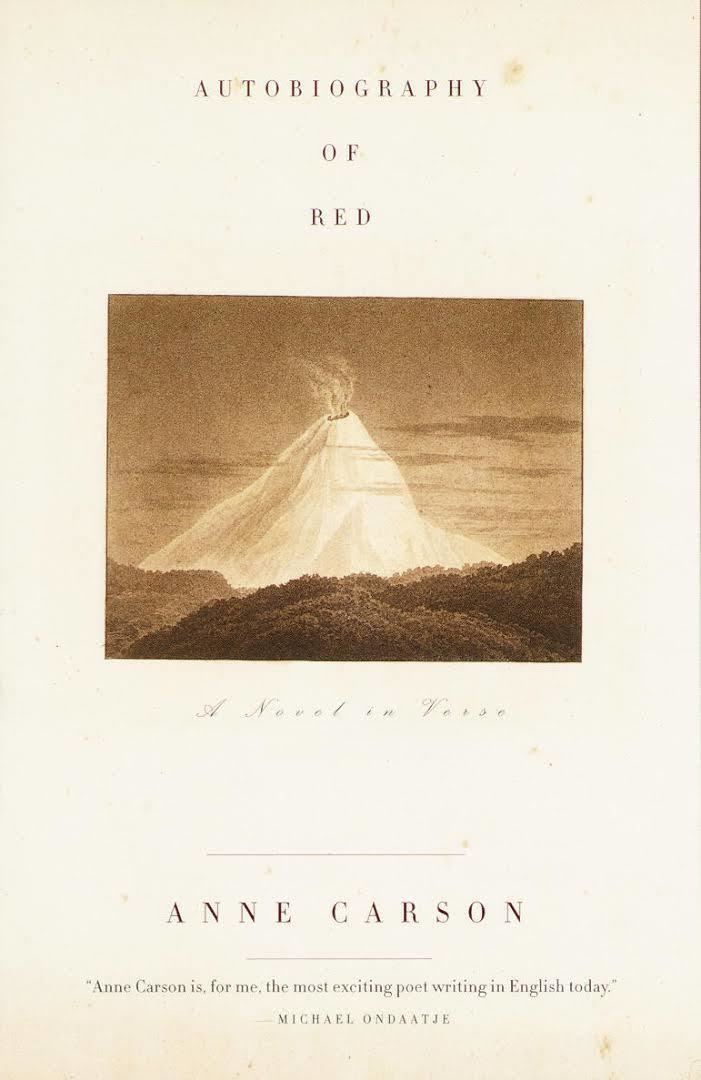8.6 /10 1 Votes8.6
ISBN 0-375-40133-4 Originally published 31 March 1998 | 4.3/5 Goodreads Publication date March 31, 1998 Pages 149 pp OCLC 37975550 Publisher Alfred A. Knopf | |||||||||||||||||||||||||||||||||
 | ||||||||||||||||||||||||||||||||||
Nominations National Book Critics Circle Award for Poetry Similar Works by Anne Carson, American poetry books | ||||||||||||||||||||||||||||||||||
Autobiography of Red (1998) is a verse novel by Anne Carson, based loosely on the myth of Geryon and the Tenth Labor of Herakles, especially on surviving fragments of the lyric poet Stesichorus' poem Geryoneis.
Contents
Reading aloud autobiography of red by anne carson
Summary
Autobiography of Red is the story of a boy named Geryon who, at least in a metaphorical sense, is the Greek monster Geryon. It is unclear how much of the mythological Geryon's connection to the story's Geryon is literal, and how much is metaphorical. Sexually abused by his older brother, his affectionate mother too weak-willed to protect him, the monstrous young boy finds solace in photography and in a romance with a young man named Herakles. Herakles leaves his young lover at the peak of Geryon's infatuation; when Geryon comes across Herakles several years later on a trip to Argentina, Herakles' new lover Ancash forms the third point of a love triangle. The novel ends, ambiguously, with Geryon, Ancash, and Herakles stopping outside a bakery near a volcano.
The book also contains Carson's very loose translation of the Geryoneis fragments, using many anachronisms and taking many liberties, and some discussion of both Stesichorus and the Geryon myth, including a fictional interview with "Stesichoros," a veiled reference to Gertrude Stein.
Reception
Autobiography of Red has been warmly received by authors and critics. In a cover story in The New York Times Magazine, critic Sam Anderson discusses the plot and reputation of Carson's verse novel.
Red has become known as one of the crossover classics of contemporary poetry: poetry that can seduce even people who don’t like poetry. It boasts one of the more impressive roster of blurbs you are ever likely to see: full-on gushing from Alice Munro, Michael Ondaatje, Susan Sontag. The book is subtitled “A Novel in Verse,” but — as usual with Carson — neither “novel” nor “verse” quite seems to apply. It begins as if it were a critical study of the ancient Greek poet Stesichoros, with special emphasis on a few surviving fragments he wrote about a minor character from Greek mythology, Geryon, a winged red monster who lives on a red island herding red cattle. Geryon is most famous as a footnote in the life of Herakles, whose 10th labor was to sail to that island and steal those cattle — in the process of which, almost as an afterthought, he killed Geryon by shooting him in the head with an arrow.
Autobiography of Red purports to be Geryon’s autobiography. Carson transposes Geryon’s story, however, into the modern world, so that he is suddenly not just a monster but a moody, artsy, gay teenage boy navigating the difficulties of sex and love and identity. His chief tormentor is Herakles, a charismatic ne’er-do-well who ends up breaking Geryon’s heart. The book is strange and sweet and funny, and the remoteness of the ancient myth crossed with the familiarity of the modern setting (hockey practice, buses, baby sitters) creates a particularly Carsonian effect: the paradox of distant closeness.
